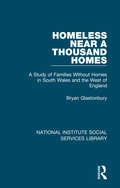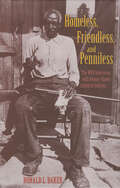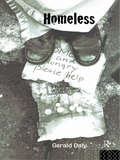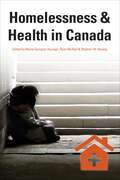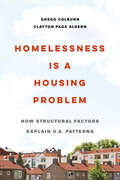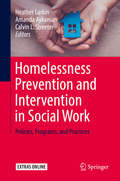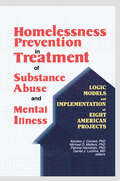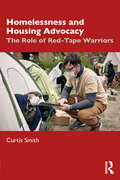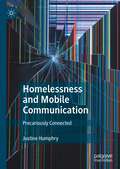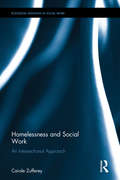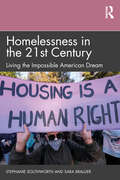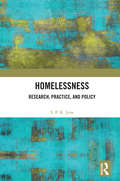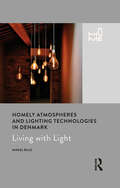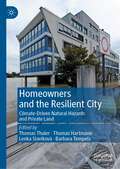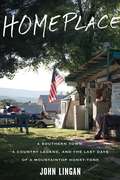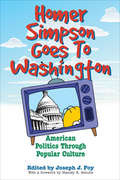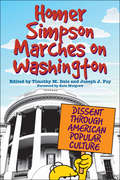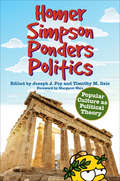- Table View
- List View
Homeless Near a Thousand Homes: A Study of Families Without Homes in South Wales and the West of England (National Institute Social Services Library)
by Bryan GlastonburyWho becomes homeless? Why? What stresses and strains do these people face? Does losing a home provoke other problems or is it a sequel to them? How far do government policies and provisions go towards meeting the needs of the homeless? What changes would be desirable? To what extent is homelessness due to housing shortages? Originally published in 1971, these and other questions are tackled in this study of the development of services for the homeless. It is based on detailed investigation of provisions in South Wales and the West Country and is a study of the lives of over 500 families who, at some stage since 1963, had lost their homes. Hitherto studies of homelessness had been restricted to London or other big urban centres. The questions posed and answered here are much more general, and relevant to all parts of the country at the time. Information for the survey came from the records kept in Local Authority Welfare, Children’s Health and Housing Departments, the Probation and After-Care Service, local offices of the Department of Health and Social Security, and many voluntary organizations. The findings suggest that, in the areas studied, homelessness was worse than anticipated, and that its demands on the social services were similar in range but different in order of priority from those in the metropolis. Poor housing conditions remain an important feature, reinforced by unhelpful attitudes in housing management. Housing shortages are important for large families and those who cannot be self-dependent – more so than for others. Looming over the whole picture is homelessness resulting from broken marriages and family disputes, with the attendant difficulties of unsupported motherhood, poverty, sickness and unemployment.
Homeless, Friendless, and Penniless: The WPA Interviews with Former Slaves Living in Indiana
by Ronald L. BakerHomeless, Friendless, and PennilessThe WPA Interviews with Former Slaves Living in IndianaRonald L. BakerLives of former slaves in their own words, published for the first time.Based on a collection of interviews conducted in the late 1930s, Homeless, Friendless, and Penniless is an invaluable record of the lives and thoughts of former slaves who moved to Indiana after the Civil War and made significant contributions to the evolving patchwork of Hoosier culture.The Indiana slave narratives provide a glimpse of slavery as remembered by those who experienced it, preserving insiders' views of a tragic chapter in American history. Though they were living in Indiana at the time of the interviews, these African Americans been enslaved in 11 different states from the Carolinas to Louisiana. The interviews deal with life and work on the plantation; the treatment of slaves; escaping from slavery; education, religion, and slave folklore; and recollections of the Civil War. Just as important, the interviews reveal how former slaves fared in Indiana after the Civil War and during the Depression. Some became ministers, a few became educators, and one became a physician; but many lived in poverty and survived on Christian faith and small government pensions.Ronald L. Baker, Chairperson and Professor of English at Indiana State University, is author of many books, including Hoosier Folk Legends and From Needmore to Prosperity: Hoosier Place Names in Folklore and History (both from Indiana University Press. He is co-author of Indiana Place Names with Marvin Carmony and editor of The Folklore Historian, the journal of the Folklore and History Section of the American Folklore Society.ContentsPart One: A Folk History of Slavery Background of the WPA Interviews Presentation of Material Living and Working on the Plantation The Treatment of Slaves Escaping from Slavery Education Religion Folklore Recollections of the Civil War Living and Working after the Civil War Value of the WPA Interviews AcknowledgmentsPart Two: The WPA Interviews with Former Slaves [134 entries]Appendices, including Thematic Index
Homeless: Policies, strategies and Lives on the Streets
by Gerald DalyThe causes of homelessness are disputed by both Right and Left. But, few would argue that life on the streets is anything other than dangerous and debilitating. Unemployment, deinstitutionalisation, abuse in the home are among the stories the homeless tell. Voluntary organisations point to the failure of emergency shelters and food banks, the cut-backs in social programmes and the severe shortage of affordable housing. On the international scale, the changing global system has placed new demands on the economies of Europe and north America which have impacted on resources, employment and even political will. This book is the first comprehensive international study of homelessness. The author argues that the category of the homeless must itself be broadened, to encompass those chronically without shelter to those in immediate risk of dispossession, if homelessness is to be tackled effectively (before and after it happens) by public policy, voluntary organisations and the individuals themselves.
Homelessness & Health in Canada (Health and Society)
by Manal Guirguis-Younger Stephen W. Hwang Ryan McNeilHomelessness & Health in Canada explores, for the first time, the social, structural, and environmental factors that shape the health of homeless persons in Canada. Covering a wide range of topics from youth homelessness to end-of-life care, the authors strive to outline policy and practice recommendations to respond to the ongoing public health crisis. This book is divided into three distinct but complimentary sections. In the first section, contributors explore how homelessness affects the health of particular homeless populations, focusing on the experiences of homeless youth, immigrants, refugees and people of Aboriginal ancestry. In the second section, contributors investigate how housing and public health policy as well as programmatic responses can address various health challenges, including severe mental illness and HIV/AIDS. In the final section, contributors highlight innovative Canadian interventions that have shown great promise in the field. Together, they form a comprehensive survey of an all too important topic and serve as a blueprint for action.
Homelessness In America
by Jim BaumohlThe number of homeless people in America has continued to grow at an alarming rate since the 1970s. Yet many members of the general public still have far more questions than answers about the magnitude and implications of this complex social problem and the reasons for its persistence. Now the answers can be found in Homelessness in America, the most current, comprehensive, and authoritative volume available on this subject. Focusing on the broad social issue of homelessness, the book's 19 essays offer in-depth examinations of policy-related issues by noted social workers, researchers, advocates, and other experts in the field. Chapter topics include the causes and prevention of homelessness, national and local advocacy movements, the local regulation of public space, and current policies on employment, income maintenance, and housing. Up-to-date statistics and tables are included along with an extensive bibliography and an appendix listing national or state advocacy organizations.
Homelessness Is a Housing Problem: How Structural Factors Explain U.S. Patterns
by Gregg Colburn Clayton Page AldernIn Homelessness Is a Housing Problem, Gregg Colburn and Clayton Page Aldern seek to explain the substantial regional variation in rates of homelessness in cities across the United States. In a departure from many analytical approaches, Colburn and Aldern shift their focus from the individual experiencing homelessness to the metropolitan area. Using accessible statistical analysis, they test a range of conventional beliefs about what drives the prevalence of homelessness in a given city—including mental illness, drug use, poverty, weather, generosity of public assistance, and low-income mobility—and find that none explain the regional variation observed across the country. Instead, housing market conditions, such as the cost and availability of rental housing, offer a far more convincing account. With rigor and clarity, Homelessness Is a Housing Problem explores U.S. cities' diverse experiences with housing precarity and offers policy solutions for unique regional contexts.
Homelessness Prevention and Intervention in Social Work: Policies, Programs, and Practices
by Calvin L. Streeter Heather Larkin Amanda AykanianThis important text provides a comprehensive survey of homelessness in America: its scope and causes, its diverse populations, and the array of responses at the individual, community, and systems levels. Expert contributors explore the links between trauma and homelessness, the cycle of homelessness and health/mental health problems, and barriers preventing people from accessing services. Case studies of effective programs and practices focus on science-based interventions, broad understanding of client needs, and close coordination between systems and agencies. Finally, specialized chapters discuss issues and experiences common to homeless youth and young adults, including housing instability on college campuses and empowerment-based strategies for engaging youth voice in programming . Included in the coverage:Homelessness and health disparities: a health equity lensAffordable housing and housing policy responses to homelessnessStreet talk: homeless discourses and the politics of service provisionMultisectoral collaborations to address homelessnessTrauma-informed care in homelessness service settings: challenges and opportunitiesIncorporating youth voice into services for young people experiencing homelessnessHomelessness Prevention and Intervention in Social Work fills a critical gap in the social work curriculum as a main or a supplementary text. It also makes an accessible resource for clinicians and community practitioners seeking current knowledge on the topic, practical approaches to working with clients experiencing homelessness, and useful information for effective program and policy design.
Homelessness Prevention in Treatment of Substance Abuse and Mental Illness: Logic Models and Implementation of Eight American Projects
by Patricia Hanrahan Michael D Matters Kendon J ConradThrough Homelessness Prevention in Treatment of Substance Abuse and Mental Illness: Logic Models and Implementation of Eight American Projects, psychiatrist, psychologists, and social workers will discover the results of eight, three-year long development projects funded by the Substance Abuse and Mental Health Services Administration (SAMHSA) designed to prevent homelessness in high- risk populations who have problems with alcoholism, drug abuse, and/or mental illness. Through this informative book, you will examine the theory or logic guiding each program, including an up-to-date review of the literature supporting each theory. You will also find a description of the implementation of the program as well as its history, the practical issues involved in delivering services, the pitfalls, lessons learned, and recommendations for the future so you can use the best ideas to implement in your own community and stop these individuals from reaching the streets.Homelessness Prevention in Treatment of Substance Abuse and Mental Illness provides insight into how to deal with many common issues that you are faced with every day, such as matching clients to appropriate services, preventing relapse, case management, training in independent living skills and money management, acquiring and maintaining housing, and benefits and employment for your disadvantaged clients. Compelling and informative, this unique book provides you with many tips and suggestions on how you can help the disadvantaged in our population avoid the added trauma of becoming homeless, such as: examining a new modified therapeutic community (TC) intervention program for mothers recovering from substance abuse who live with their children so you can learn to treat the family as a whole and not just treat the person with a “problem” gaining insight into a new intervention program for families caring for another family member with serious mental illness or substance abuse disorders so you can address such issues as the importance of respite for the family and home visits for relationship building among the entire household discovering a new, independent living model which allows clients with serious mental illnesses to select their own apartments learning about a new program in Philadelphia that offers support services to clients with serious mental illnesses and substance use disorders and provides several levels of housing from emergency shelter to highly supportive permanent housing discovering a community counseling center in Chicago that operates a “bank” that helps mentally ill clients or those with substance use disorders develop skills to independently manage their financial affairs through the use of “vouchers” that can be redeemed for cash for the payment of monthly billsHomelessness Prevention in Treatment of Substance Abuse and Mental Illness provides you with new insights into how you can help your clients overcome political, economic, and environmental barriers to treatment that can lead to homelessness. This essential book will help you improve your services to your clients as well as give you step-by-step guide to implement these new programs in your community.
Homelessness and Housing Advocacy: The Role of Red-Tape Warriors
by Curtis SmithThrough compelling ethnography, Homelessness and Housing Advocacy: The Role of Red-Tape Warriors reveals the creative and ambitious methods that social service providers use to house their clients despite the conflictual conditions posed by the policies and institutions that govern the housing process. Combining in-depth interviews, extensive fieldwork, and the author’s own professional experience, this book considers the perspective of social service providers who work with people experiencing homelessness and chronicles the steps they take to navigate the housing process. With assertive methods of worker-client advocacy at the center of its focus, this book beckons attention to the many variables that affect professional attempts to house homeless populations. It conveys the challenges that social service providers encounter while fitting their clients into the criteria for housing eligibility, the opposition they receive, and the innovative approaches they ultimately take to optimize housing placements for their clients who are, or were formerly, experiencing homelessness. Weaving as it does between issues of poverty, social inequality, and social policy, Homelessness and Housing Advocacy will appeal to courses in social work, sociology, and public policy and fill a void for early-career professionals in housing and community services.
Homelessness and Mobile Communication: Precariously Connected
by Justine HumphryThis book examines how mobile phones and the internet have become a vital part of the everyday lives of people experiencing homelessness. But the access mobile phones provide is costly, insecure and limited, producing an experience of being precariously connected. Drawing on findings of research conducted with over one hundred young people, families and adults experiencing homelessness in Australia and the United States, this book analyses homelessness as a mediated condition and explores the underpinning processes that shape digital disparities. It contributes to scholarship on mobile communication and inequality, highlighting the digital patterns, issues and difficulties of a group disproportionately affected by service reform and developments in digital citizenship, smart cities and algorithmic governance.
Homelessness and Social Work: An Intersectional Approach (Routledge Advances in Social Work)
by Carole ZuffereyDrawing on intersectional theorising, Homelessness and Social Work highlights the diversities and complexities of homelessness and social work research, policy and practice. It invites social work students, practitioners, policy makers and academics to re-examine the subject by exploring how homelessness and social work are constituted through intersecting and unequal power relations. The causes of homelessness are frequently associated with individualist explanations, without examining the broader political and intersecting social inequalities that shape how social problems such as homelessness are constructed and responded to by social workers. In reflecting on factors such as Indigeneity, race, ethnicity, gender, class, age, sexuality, ability and other markers of identity the author seeks to: • construct a new intersectional framework for understanding social work and homelessness; • provide a critical analysis of social work responses to homelessness; • challenge how homelessness is represented in social work research, social policy and social work practice; and • incorporate the stories of people experiencing homelessness. The book will be of interest to undergraduate and higher research degree students in the fields of intersectionality, homelessness, sociology, public policy and social work.
Homelessness in America: Perspectives, Characterizations, and Considerations for Occupational Therapy
by Kathleen Swenso Miller Georgiana L Herzberg Sharon A RayLearn how to better address the needs of the homelessThe causes of homelessness are complex and varied. Homelessness in America provides an overview of the state of research on the homeless population from an occupation and societal participation perspective. This important resource explores the systems of care in which homeless services are organized, the tailoring of services to meet the needs of diverse types of homeless, the newest trends in services, and crucial funding sources. Research is comprehensively examined from an occupation-based perspective, including studies on specific issues pertaining to various homeless populations. This in-depth discussion provides a vital understanding of homelessness using a client-centered and strengths-based approach in occupational therapy. Much of the research and writings of occupational therapists who work with homeless populations has been scattered throughout various diverse publications. Homelessness in America: Perspectives, Characterizations, and Considerations for Occupational Therapy gathers into one useful volume important insights, practical strategies, and valuable research into the many challenges concerning homelessness. Various effective interventions are discussed in depth. Several leading authorities explore current issues and offer illuminating case studies, extensive reference lists, and helpful tables of funding sources.Topics in Homelessness in America include: results of an Internet-based survey of assessment tools used with the homeless a critical examination of the assumptions of who becomes homeless-and why typologies of homelessness current trends in service delivery federal organization and sources of funding for services exploratory study of occupational concerns and goals of homeless women with children study illustrating the value of the theory of Occupational Adaptation mother-toddler interactions in transitional housing the role of occupational therapy in the youth homelessness problem homeless youths&’ after-school and weekend time use guiding intervention by using the Model of Human Occupation (MOHO) productive role involvement at Project Employ study on life skills interventions with effective recommendations much moreHomelessness in America is insightful, important reading for occupational therapy educators, students, practicing occupational therapists, program directors of services to the homeless, and policymakers.
Homelessness in Rural America: Policy and Practice
by Paula A. Rollinson John T. PardeckThis book deals with the rural homeless, about whom little is known. Offered here are some important insights into the unique problems facing the homeless in rural areas: this population lacks adequate housing, many live below the poverty level, many lack basic services such as health care, families are typically female headed, substance abuse is a major problem, and many of the rural homeless have emotional disabilities. The finding that was unexpected is the history of family violence that most of the rural homeless have experienced throughout both childhood and adulthood. More than 50 percent of the case records analyzed in this study show a history of family violence, from murder to sexual abuse. The data suggest that these rates of family violence are much higher than those reported for the urban homeless. First published in 2006. Routledge is an imprint of Taylor & Francis, an informa company.
Homelessness in the 21st Century: Living the Impossible American Dream
by Stephanie Southworth Sara BrallierAn accessible and engaging introductory text on homelessness and housing policy, this timely book uses a sociopolitical framework for understanding issues of homelessness in the United States. The authors, leading sociologists in their field, use data from over 250 interviews and field notes to demonstrate that homelessness is rooted in the structure of our society. They identify and describe the structural barriers faced by people who become homeless including the lack of affordable housing, the stigmatization and criminalization of homelessness, inadequate access to healthcare, employment that does not pay a living wage, and difficulty accessing social services. Despite seemingly insurmountable odds, most of the people included in this book believe strongly in the American Dream. This book examines how the belief in the American Dream affects people experiencing homelessness. It also highlights individuals’ experiences within the social institutions of the economy, the criminal justice system, and the health care system. Furthermore, this book explores how stereotypes of people experiencing homelessness affects individuals and guides social policy. The authors examine policy changes at the local, state, and national levels that can be made to eradicate homelessness, but argue that there must be a political will to shift the narrative from blaming the victim to supporting the common good. Expertly combining history, theory and ethnography, this book is an invaluable resource for those with an interest in housing policy.
Homelessness, Health Care and Welfare Provision
by John Collins Kevin FisherHomelessness, Health Care and Welfare Provision is the first known publication in which service providers examine the particular difficulties encountered by homeless people in gaining access to healthcare, both in Britain and the US. Specific chapters examine the complex issue of mental health and homelessness, responses to single homeless people with drink-related problems and the particular problems experienced by young single homeless people and homeless women. _
Homelessness: Research, Practice, and Policy
by S. P. JenaThis book provides insights into the experiences of ‘homelessness’, while exploring its psychological and socio-economic dimensions. Hunger, addiction, and disability, which often accompany homelessness, are brought into focus and discussed within the frameworks of promoting social welfare and enabling human capability in this volume. Based on the author’s ethnographic and quantitative research on homeless families living on the streets of Delhi, this book identifies some of the most acute problems associated with homelessness. It analyzes the causes of homelessness and draws connections between social bonds and family, socio-economic status, and psychopathology. It also includes personal accounts of hardship and trauma which quantify the systematic discrimination and marginalization that people living on the streets face. The volume offers policy recommendations to protect the right to self-determination, dignity, and self-efficacy of the homeless and help rehabilitate them. It will be a useful guide for students and researchers of social sciences specializing in psychology, sociology, economics, and development studies. The book will also be of interest to mental health professionals and policy-makers in designing effective strategies.
Homelessness: The (In)Appropriate Applicant (Routledge Revivals)
by David CowanFirst published in 1997, this volume presents the results of in-depth research into the application of the UK homelessness legislation in relation to community care, the Children Act 1989, violence to women, and racial harassment. This is supplemented with a consideration of policies and practices in 15 local authority homelessness departments. It is argued that government created the nation of a successful, or "appropriate" applicant, but this could not be translated into actual practice as the original legislation did not facilitate it. In fact, in the mid-1990s, government became more concerned with notions of inappropriateness, stereotyping those using the homelessness legislation and creating modern "folk devils". This was the background to the 1996 changes to the homelessness legislation which have created the notion of the "inappropriate" applicant. It is argued that the new legislation is more concerned with denial, deterrence and privatization. The new legislation has also detrimentally affected the application of the homelessness legislation in each of the areas discussed.
Homely Atmospheres and Lighting Technologies in Denmark: Living with Light (Home Ser.)
by Mikkel BilleUsing case studies, such as the use of candlelight and energy saving lightbulbs in Denmark, this book unravels light’s place at the heart of social life. In contrast to common perception of light as a technical and aesthetic phenomenon, Mikkel Bille argues that there is a cultural and social logic to lighting practices. By empirically investigating the social role of lighting in people's everyday lives, Mikkel Bille reveals how and why people visually shape their homes. Moving beyond the impact of its use, Bille also comments on the politics of lighting to examine how ideas of pollution and home act as barriers for technological fixes to curb energy demand. Attitudes to these issues are reflective of how human perceptions and practices are central to the efforts to cope with climate change. This ethnographic study is a must-read for students of anthropology, cultural studies, human geography, sociology and design.
Homeowners and the Resilient City: Climate-Driven Natural Hazards and Private Land
by Thomas Thaler Thomas Hartmann Lenka Slavíková Barbara TempelsThis book provides an important overview of how climate-driven natural hazards like river or pluvial floods, droughts, heat waves or forest fires, continue to play a central role across the globe in the 21st century. Urban resilience has become an important term in response to climate change. Resilience describes the ability of a system to absorb shocks and depends on the vulnerability and recovery time of a system. A shock affects a system to the extent that it becomes vulnerable to the event. This book focus examines how private property-owners might implement such measures or improve their individual coping and adaptive capacity to respond to future events. The book looks at the existence of various planning, legal, financial incentives and psychological factors designed to encourage individuals to take an active role in natural hazard risk management and through the presentation of theoretical discussions and empirical cases shows how urban resilience can be achieved. In addition, the book guides the reader through different conceptual frameworks by showing how urban regions are trying to reach urban resilience on privately-owned land. Each chapter focuses on different cultural, socio-economic and political backgrounds to demonstrate how different institutional frameworks have an impact.
Homeplace: A Southern Town, a Country Legend, and the Last Days of a Mountaintop Honky-Tonk
by John LinganAn intimate account of country music, social change, and a vanishing way of life as a Shenandoah town collides with the twenty-first century Winchester, Virginia is an emblematic American town. When John Lingan first traveled there, it was to seek out Jim McCoy: local honky-tonk owner and the DJ who first gave airtime to a brassy-voiced singer known as Patsy Cline, setting her on a course for fame that outlasted her tragically short life. What Lingan found was a town in the midst of an identity crisis. As the U.S. economy and American culture have transformed in recent decades, the ground under centuries-old social codes has shifted, throwing old folkways into chaos. Homeplace teases apart the tangle of class, race, and family origin that still defines the town, and illuminates questions that now dominate our national conversation—about how we move into the future without pretending our past doesn't exist, about what we salvage and what we leave behind. Lingan writes in &“penetrating, soulful ways about the intersection between place and personality, individual and collective, spirit and song.&”* * Leslie Jamison, author of The Empathy Exams
Homer Simpson Goes To Washington: American Politics Through Popular Culture
by Joseph J. Foy&“Informative and entertaining . . . convincingly argue[s] that an interest in popular culture can counterbalance the growing tide of political apathy.&” —Publishers Weekly While pundits may accuse popular culture of brainwashing, indoctrinating, distracting, or dumbing down the masses, the fact is that Americans have long turned to entertainment sources to make sense of politics, through television shows such as The Simpsons, The West Wing, The Daily Show, and Chappelle&’s Show and films such as Election, Bulworth, and Wag the Dog. In Homer Simpson Goes to Washington, Joseph J. Foy has assembled a multidisciplinary team of scholars with backgrounds in political science, philosophy, law, cultural studies, and music. Their essays tackle common assumptions about government and explain fundamental concepts such as civil rights, democracy, and ethics—through the lens of drama and comedy.
Homer Simpson Marches on Washington: Dissent through American Popular Culture
by Timothy M. Dale and Joseph J. FoyA volume of enlightening essays on how TV shows, movies, and music can change hearts and minds. Amid all its frenetic humor, the long-running animated hit The Simpsons has often questioned what is culturally acceptable, wading into controversial subjects like gay rights, the war on terror, religion, and animal rights. This subtle form of political analysis is effective in changing opinions and attitudes on a large scale. Homer Simpson Marches on Washington explores the transformative power that enables popular culture to influence political agendas, frame the consciousness of audiences, and create profound shifts in values and ideals. To investigate the full spectrum of popular culture in a democratic society, editors Timothy M. Dale and Joseph J. Foy gather a top-notch team of scholars who use television shows such as Star Trek, The X-Files, All in the Family, The View, The Daily Show, and The Colbert Report, as well as movies and popular music, to investigate contemporary issues in American popular culture.
Homer Simpson Ponders Politics: Popular Culture as Political Theory
by Timothy M. DaleWhat pop culture from The Hobbit to The Office reveals about modern politics—from the authors of Homer Simpson Marches on Washington: “Fun and engaging.” —William Irwin, author of Black Sabbath and PhilosophyIt’s said that the poet Homer educated ancient Greece. Joseph J. Foy and Timothy M. Dale have assembled a team of notable scholars who argue, quite persuasively, that Homer Simpson and his ilk are educating America and offering insights into the social order and the human condition.Following Homer Simpson Goes to Washington (winner of the John G. Cawelti Award for Best Textbook or Primer on American and Popular Culture) and Homer Simpson Marches on Washington, this exceptional volume reveals how books like J. R. R. Tolkien’s The Hobbit and J. K. Rowling’s Harry Potter, movies like Avatar and Star Wars, and television shows like The Office and Firefly define Americans’ perceptions of society. The authors expand the discussion to explore the ways in which political theories play out in popular culture.Homer Simpson Ponders Politics includes a foreword by fantasy author Margaret Weis (coauthor/creator of the Dragonlance novels and game world) and is divided according to eras and themes in political thought: The first section explores civic virtue, applying the work of Plato and Aristotle to modern media. Part 2 draws on the philosophy of Hobbes, Locke, Rousseau, and Smith as a framework for understanding the role of the state. Part 3 explores the work of theorists such as Kant and Marx, and the final section investigates the ways in which movies and newer forms of electronic media either support or challenge the underlying assumptions of the democratic order. The result is an engaging read for students as well as anyone interested in popular culture.
Homer in Stone
by David PetrainThe Tabulae Iliacae are a group of carved stone plaques created in the context of early Imperial Rome that use miniature images and text to retell stories from Greek myth and history - chief among them Homer's Iliad and the fall of Troy. In this book, Professor Petrain moves beyond the narrow focus on the literary and iconographic sources of the Tabulae that has characterized earlier scholarship. Drawing on ancient and modern theories of narrative, he explores instead how the tablets transfer the Troy saga across both medium and culture as they create a system of visual storytelling that relies on the values and viewing habits of Roman viewers. The book comprehensively situates the tablets in the urban fabric of Augustan Rome. New photographs of the tablets, together with re-editions and translations of key inscriptions, offer a new, clearer view of these remarkable documents of the Roman appropriation of Greek epic.
Homer's Odyssey and the Near East
by Bruce LoudenThe Odyssey's larger plot is composed of a number of distinct genres of myth, all of which are extant in various Near Eastern cultures (Mesopotamian, West Semitic, Egyptian). Unexpectedly, the Near Eastern culture with which the Odyssey has the most parallels is the Old Testament. Consideration of how much of the Odyssey focuses on non-heroic episodes - hosts receiving guests, a king disguised as a beggar, recognition scenes between long-separated family members - reaffirms the Odyssey's parallels with the Bible. In particular the book argues that the Odyssey is in a dialogic relationship with Genesis, which features the same three types of myth that comprise the majority of the Odyssey: theoxeny, romance (Joseph in Egypt), and Argonautic myth (Jacob winning Rachel from Laban). The Odyssey also offers intriguing parallels to the Book of Jonah, and Odysseus' treatment by the suitors offers close parallels to the Gospels' depiction of Christ in Jerusalem.
